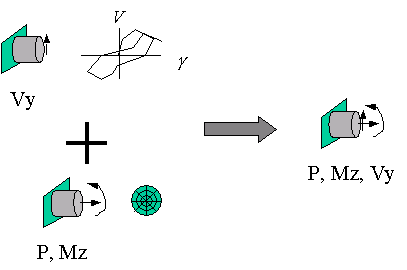This command is used to construct a SectionAggregator object which groups previously-defined UniaxialMaterial objects into a single section force-deformation model.
section Aggregator $secTag $matTag1 $string1 $matTag2 $string2 ....... <-section $sectionTag>
$secTag |
unique section object integer tag |
||
$matTag1, $matTag2 ... |
previously-defined UniaxialMaterial objects |
||
$string1, $string2 .... |
the force-deformation quantities corresponding to each section object. One of the following strings is used: |
||
|
P |
Axial force-deformation |
|
|
Mz |
Moment-curvature about section local z-axis |
|
|
Vy |
Shear force-deformation along section local y-axis |
|
|
My |
Moment-curvature about section local y-axis |
|
|
Vz |
Shear force-deformation along section local z-axis |
|
|
T |
Torsion Force-Deformation |
|
<-section $sectionTag> |
specifies a previously-defined Section object (identified by the argument $sectionTag) to which these UniaxialMaterial objects may be added to recursively define a new Section object |
||
NOTE: The UniaxialMaterial objects aggregated in this Section object are uncoupled from each other as well as from the Section object represented by $sectionTag, if present.
There are two main tasks that can be performed using the Section Aggregator:

EXAMPLE:
section Aggregator 1 2 Vy 5 Mz; #create new section with IDtag 1, taking the existing material tag 2 to represent the shear and the existing material tag 5 to represent the moment.

EXAMPLE:
section Aggregator 2 2 Vy -section 4; # create new section with IDtag 2, taking the existing material tag 2 to represent the shear and adding it to the existing section tag 4, which may be a fiber section where the interaction betweeen axial force and flexure is already considered.